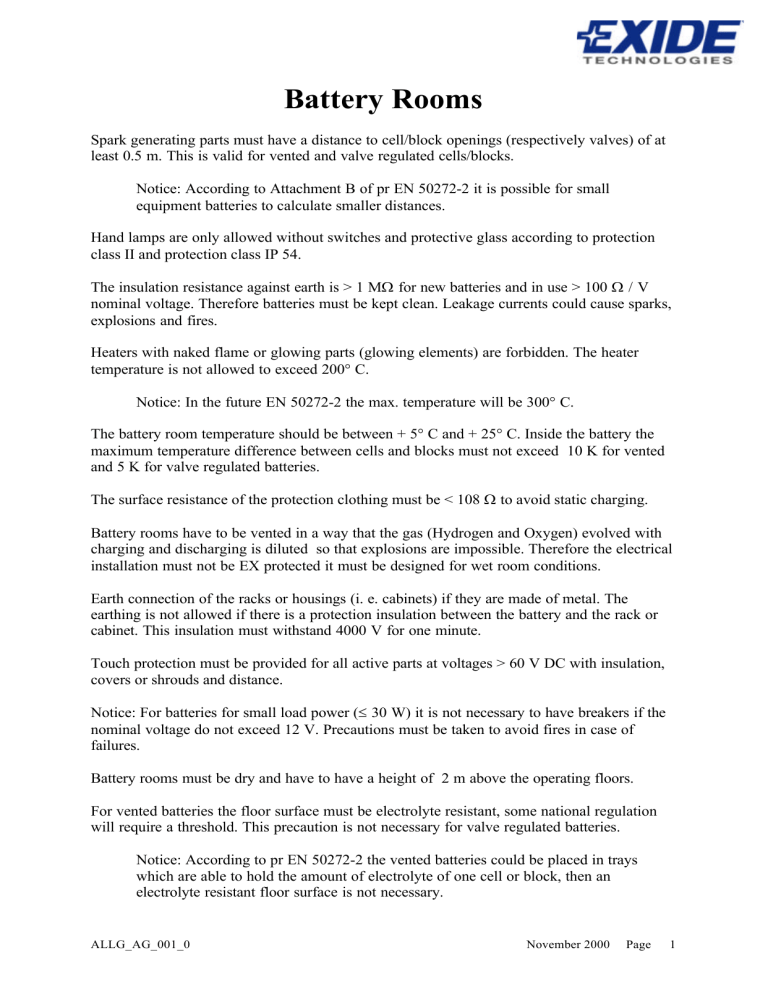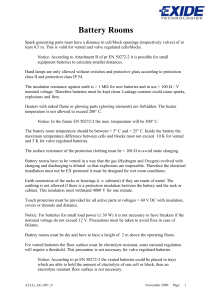
Battery Rooms Spark generating parts must have a distance to cell/block openings (respectively valves) of at least 0.5 m. This is valid for vented and valve regulated cells/blocks. Notice: According to Attachment B of pr EN 50272-2 it is possible for small equipment batteries to calculate smaller distances. Hand lamps are only allowed without switches and protective glass according to protection class II and protection class IP 54. The insulation resistance against earth is > 1 MΩ for new batteries and in use > 100 Ω / V nominal voltage. Therefore batteries must be kept clean. Leakage currents could cause sparks, explosions and fires. Heaters with naked flame or glowing parts (glowing elements) are forbidden. The heater temperature is not allowed to exceed 200° C. Notice: In the future EN 50272-2 the max. temperature will be 300° C. The battery room temperature should be between + 5° C and + 25° C. Inside the battery the maximum temperature difference between cells and blocks must not exceed 10 K for vented and 5 K for valve regulated batteries. The surface resistance of the protection clothing must be < 108 Ω to avoid static charging. Battery rooms have to be vented in a way that the gas (Hydrogen and Oxygen) evolved with charging and discharging is diluted so that explosions are impossible. Therefore the electrical installation must not be EX protected it must be designed for wet room conditions. Earth connection of the racks or housings (i. e. cabinets) if they are made of metal. The earthing is not allowed if there is a protection insulation between the battery and the rack or cabinet. This insulation must withstand 4000 V for one minute. Touch protection must be provided for all active parts at voltages > 60 V DC with insulation, covers or shrouds and distance. Notice: For batteries for small load power (≤ 30 W) it is not necessary to have breakers if the nominal voltage do not exceed 12 V. Precautions must be taken to avoid fires in case of failures. Battery rooms must be dry and have to have a height of 2 m above the operating floors. For vented batteries the floor surface must be electrolyte resistant, some national regulation will require a threshold. This precaution is not necessary for valve regulated batteries. Notice: According to pr EN 50272-2 the vented batteries could be placed in trays which are able to hold the amount of electrolyte of one cell or block, then an electrolyte resistant floor surface is not necessary. ALLG_AG_001_0 November 2000 Page 1 Battery Room Ventilation The way of air circulation should be as shown below. If the air in and air out are on the same side the room free volume must be greater than 2.5 times of the calculated air volume. Notice: In pr EN 50272-2 is a minimum distance between inlet and outlet of 2 m requested. For calculation of the hourly to exchange air volume Q the following formula is valid: Q = 0.05 x n x I [m³/h] n = number of cells I = Value for the current from Table of pr EN 50272-2 Calculation Example: Given: 220 V battery, 400 Ah, vented type, Antimony (Sb) < 3 % (LA) in FLOAT-service Q = 0.05 x n x I [m³/h] Ired = f1 x f2 x I Ired = reduced current (f1 and f2 see operating instruction of battery Q = 0.05 x 100 x 4 x 0.5 f1 = 0.5 if Sb in Pb is < 3 %, IU-charging up to 2.4 VPC f2 = 0.5 if the cell is valve regulated or a catalytic plug is used I = current (Table) in the example 1 A / 100 Ah n = number of cells, in the example 110 Q = 11 m3/h ALLG_AG_001_0 November 2000 Page 2 With natural ventilation (air convection) the minimum inlet and outlet area is calculated as follows: A ≥ 28 x Q [cm²] (Air convection speed ≥ 0.1 m/s) From this the minimum area for inlet and outlet to change hourly the calculated air volume of the example is: A = 28 x 11 m³/h = 308 cm² For mechanical ventilation the fan must be working during charging operation. If the charging is done above the gassing voltage of 2.4 VPC for lead acid batteries the fan must run at least for one hour after end of charging. If batteries are assembled in cabinets and used inside working areas it is required that the free air volume of the working area is ≥ 2.5 times of the air volume Q. Otherwise a mechanical ventilation is required. ALLG_AG_001_0 November 2000 Page 3 Battery Installation Batteries must be secured against dropping items and dirt. It is necessary to have an insulation or a distance of at least 10mm for ≥ 24 V potential difference to avoid parasitic currents. (Fire Protection) The course width between battery rows is equal to 1.5 times the cell depth (replacement) but minimum ≥ 500 mm. Notice: According to pr EN 50272-2 the course width is 0.6 m The minimum distance for > 120 V between active parts is 1.5 m or insulation, insulated cover etc. The minimum cell or block distance according pr EN 50272-2 is 5mm (at the largest dimension). Better is a distance of 10 mm to not reduce the service life of the battery by higher temperature or temperature differences between cells and blocks. The distance to the wall for racks and cabinets is ≥ 100 mm for a better placement of connections and better access for cleaning. Batteries must be assessable easy that service with normal insulated tools can be made (pr EN 50272-2). Important Notice: The manufacturer of batteries EXIDE do not take over responsibility for any loyalties resulting from this paper or resulting from changing in the mentioned standards, neither for any different national standards which may exist and has to be followed by the installer, planner or architect. ALLG_AG_001_0 November 2000 Page 4


